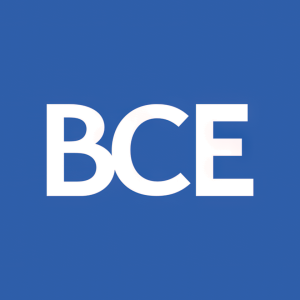BCE outlines strategic plan to drive sustainable free cash flow growth and long-term shareholder value
Rhea-AI Summary
BCE (TSX: BCE) unveiled a three-year strategic plan (2025–2028) targeting sustainable free cash flow growth and total shareholder return. Key targets include ~15% CAGR in free cash flow after payment of lease liabilities, $1.5 billion of cost savings by 2028, capital intensity falling to ~14%, and a net debt leverage ratio target of 3.5x by end of 2027 with a path to ~3.0x by 2030. The plan forecasts 2%–4% revenue CAGR and 2%–3% adjusted EBITDA CAGR, ~$5 billion in common dividends over three years, and expanded fibre reach via Network FiberCo and Ziply Fiber.
Positive
- Free cash flow after leases ~15% CAGR (2025–2028)
- $1.5 billion cost savings target by 2028
- ~$5 billion in common dividends over next three years
- Revenue growth guidance of 2%–4% CAGR (2025–2028)
- Network FiberCo expands potential fibre reach to 16+ million locations
Negative
- Net debt leverage ~3.8x in 2025 midpoint (elevated leverage)
- Capital intensity only reduces from ~15% to ~14% by 2028
- Adjusted EBITDA growth guidance modest at 2%–3% CAGR
News Market Reaction 16 Alerts
On the day this news was published, BCE gained 5.27%, reflecting a notable positive market reaction. Our momentum scanner triggered 16 alerts that day, indicating notable trading interest and price volatility. The stock closed at $24.56 on that trading session. This price movement added approximately $1.15B to the company's valuation, bringing the market cap to $22.90B at that time.
Data tracked by StockTitan Argus on the day of publication.
This news release contains forward-looking statements. For a description of the related risk factors and assumptions, please see the section entitled "Caution Concerning Forward-Looking Statements" later in this news release.
- Three-year strategic plan, guided by four core priorities, designed to deliver sustainable growth across all key business units
- Approximately
15% expected CAGR in free cash flow after payment of lease liabilities1 between 2025 and 2028 $1.5 billion - Capital intensity2 expected to decrease to approximately
14% by 2028, supporting improved cash flow and investment flexibility - Net debt leverage ratio3 target of 3.5x by the end of 2027, with clear path toward approximately 3.0x by 2030
- Sustainable dividend strategy with approximately
$5 billion - Strategic partnership with PSP Investments for the formation of Network FiberCo enables a long-term future potential fibre expansion of up to 8 million
U.S. locations, increasing BCE's potential total fibre reach to up to 16+ million locations inNorth America
"For the past 145 years, Bell has been connecting Canadians. Connection is the foundation of our company and at the heart of our purpose: to advance how people connect with each other and the world," said Mirko Bibic, President and CEO, BCE Inc. and Bell Canada.
"As we look ahead to the next several years and connecting future generations through the infrastructure we're building today, from fibre to 5G to AI-powered solutions, I'm pleased to unveil BCE's plan to deliver total shareholder return. Our strategy, anchored by four strategic priorities – put the customer first; deliver the best fibre and wireless networks; lead in enterprise with AI-powered solutions; and build a digital media and content powerhouse – is focused on the core areas that will deliver sustainable growth for our investors."
________________
|
1 Free cash flow after payment of lease liabilities is a Non-GAAP financial measure. The most directly comparable financial measure for free cash flow after payment of lease liabilities ( |
|
2 Capital intensity is defined as capital expenditures divided by operating revenues. Refer to the Key Performance Indicators (KPIs) section in this news release for more information on capital intensity. |
|
3 Net debt used in the calculation of the net debt leverage ratio is a Non-GAAP financial measure. Net debt leverage ratio is a capital management measure. The most directly comparable financial measure for net debt ( |
|
4 Subject to the discretion of, and dividends being declared by, the BCE Board of Directors. Refer to the Caution Regarding Forward-Looking Statements section in this news release for more information. |
Between 2025 and the end of 2028, BCE expects to deliver total shareholder return with a focus on sustainable revenue and EBITDA growth across its core operating businesses and drive operating efficiencies, including:
- Revenue growth at a compound annual growth rate (CAGR) of
2% to4% $1.5 billion - Adjusted EBITDA5 growth at
2% to3% CAGR - Free cash flow after payment of lease liabilities growth at approximately
15% CAGR - Approximately
$5 billion
BCE provided its financial outlook for the 2025-2028 period, as per the table below.
|
($ billions) |
|||
|
|
2025
(mid-point of |
2028 outlook |
CAGR 2025-2028E |
|
Revenue |
~ |
|
|
|
Adjusted EBITDA |
~ |
|
|
|
Capital intensity |
~ |
~ |
n.m. |
|
Free cash flow7 |
~ |
~ |
~ |
|
Free cash flow after payment of lease liabilities |
~ |
~ |
~ |
|
Net debt leverage ratio |
~ 3.8x |
<3.5x |
|
_________________
|
5 Adjusted EBITDA is a total of segments measure. The most directly comparable financial measure for adjusted EBITDA ( |
|
6 Updated 2025 financial guidance targets were released on August 7, 2025. |
|
7 Free cash flow is a non-GAAP financial measure. The most directly comparable financial measure for free cash flow ( |
BCE's disciplined capital allocation strategy, supported by strong free cash flow growth, positions the company to drive total shareholder return. Over the next three years, BCE expects to generate approximately
The company's capital allocation strategy is anchored to the following priorities:
- Balance sheet strength: BCE is committed to deleveraging, with a target net debt leverage ratio of 3.5x by the end of 2027, falling below 3.5x in 2028, and approaching approximately 3.0x by 2030.
- Cost of capital optimization: The company continues to pursue strategic partnerships and initiatives aimed at optimizing its cost of capital.
- Funding strategic priorities: Capital will be directed toward initiatives that drive long-term growth and operational efficiency.
-
Sustainable dividend policy: BCE's current annualized common share dividend of
$1.75 40% -55% of free cash flow and expects to distribute approximately$5 billion
________________
|
8 Free cash flow pre-capex and payment of lease liabilities is a non-GAAP financial measure. The most directly comparable financial measure for free cash flow pre-capex and payment of lease liabilities ( |
|
9 Dividend payout ratio is a non-GAAP ratio. Refer to the Non-GAAP and Other Financial Measures section in this news release for more information on this measure. |
Bell's long-term strategy is centered on its unique and differentiated set of assets, focused strategic priorities, proven track record of driving efficiencies and disciplined approach to capital allocation. Bell is poised to meet growing industry demand, generate strong free cash flow and provide investors with a total return that balances growth and a sustainable dividend.
The next era at Bell will be guided by four focused strategic priorities:
- Put the customer first
- Deliver the best fibre and wireless networks
- Lead in enterprise with AI-powered solutions
- Build a digital media and content powerhouse
Over the past five years, Bell has made foundational investments in customer experience and operational simplicity driven by AI that will continue to improve customer retention and generate significant annual cost efficiencies.
Bell has over 240 million direct customer interactions every year, and this reach has enabled Bell to identify the services customers want and refine its customer tools and delivery for a seamless experience. Over the next three years, through ongoing improvements to customer experience, Bell expects to achieve a higher Net Promoter Score, lower churn, higher product intensity and higher customer lifetime value.
Bell is
Bell's fibre footprint leads in the Canadian market with more than double the locations passed versus our next leading competitor. In new fibre footprints, we see penetration more than double from
Where Bell has fibre,
Over the next three years, Bell expects to reduce postpaid wireless and converged household churn10 rates by approximately 30 bps and drive
Bell today announced several new initiatives to reach more customers, enhance resiliency and deliver the easy experience customers want:
- Introduction of tiered wireless plans with rates differing based on class of service, content, and handset financing, available now across
Canada . - Launch of Internet services in
British Columbia andAlberta in the coming weeks. - Introduction of Unbreakable Internet in Spring 2026, a unique product proposition that ensures ultra resilient Internet that keeps working during power outages through a combination of wireless backups enabled by Bell Mobility 5G smartphones and the fibre network's passive optical technology.
- Planned elimination of the TV set-top box, as Bell delivers a cutting-edge, full-service experience through apps on devices customers already own.
- Expansion of Bell Streaming bundles in select markets to include Crave with TSN/RDS, alongside existing partnerships with Netflix and Disney+, and by integrating high-value third party services for AI, gaming, and security.
Bell, with AST SpaceMobile, recently announced the successful completion of a satellite direct-to-cell 4G voice over LTE (VoLTE) call, video call, broadband data connectivity and video streaming over a Canadian wireless network. The demonstration lays the groundwork for Bell's planned nationwide deployment of low Earth orbit direct-to-cell service in 2026.
Bell is also simplifying its go-to-market strategy to be more agile and more efficient by streamlining its brands, focusing its Internet and mobility bundling with the Bell brand. As a first step, Bell will stop selling Virgin Plus Internet and TV in
In addition, Bell expects to more than double its digital transaction mix by 2028, supporting a better customer experience at lower cost.
________________
|
10 Refer to the Key Performance Indicators (KPIs) section in this news release for more information on churn and subscriber units. |
In August 2025, BCE completed its acquisition of Ziply Fiber, the leading fibre Internet provider in the Pacific Northwest of
Ziply Fiber expects to double its fibre footprint to approximately 3 million locations by the end of 2028.
Bell has created a portfolio of AI-powered enterprise solutions, helping customers unleash the potential of AI within their businesses. These new services leverage Bell's leadership position as the trusted telecommunications solutions provider to most of
Bell extended its expertise across the country this year, establishing Ateko in
- Reinvent our core services and service delivery
- Lead in cybersecurity through Bell Cyber
- Build Ateko into the leading service integrator of AI automation platforms
- Extend Bell AI Fabric's leadership
In 2020, Bell understood that the media industry was undergoing a major shift toward digital. By embracing this change and meeting customers where they are in the world of on-demand and streaming services, the company began repositioning itself to become a digital media and content powerhouse.
Bell Media digital revenue mix was
Crave will expand to offer more than 40,000 hours of content by the end of 2025 fuelled by long-term agreements with Warner Bros. Discovery, Starz, Disney, Sony and NBCUniversal, with a broader kids offering and select sports, entertainment and news.
______________
|
11 Digital revenues are comprised of advertising revenue from digital platforms including web sites, mobile apps, connected TV apps and out-of-home (OOH) digital assets/platforms, as well as advertising procured through Bell digital buying platforms and subscription revenue from direct-to-consumer services and video-on-demand services. |
BCE will share further details on its strategic plan and initiatives to drive total shareholder return during its presentation today, beginning at 8:30 a.m. ET. BCE's 2025 Investor Day presentation webcast, replay and related materials will be available at BCE.ca.
BCE is
_________________
|
12 Based on total revenue and total combined customer connections. |
Media inquiries
Ellen Murphy
media@bell.ca
Investor inquiries
Krishna Somers
krishna.somers@bell.ca
BCE uses various financial measures to assess its business performance. Certain of these measures are calculated in accordance with IFRS® Accounting Standards or GAAP while certain other measures do not have a standardized meaning under GAAP. We believe that our GAAP financial measures, read together with adjusted non-GAAP and other financial measures, provide readers with a better understanding of how management assesses BCE's performance.
National Instrument 52-112, Non-GAAP and Other Financial Measures Disclosure (NI 52-112), prescribes disclosure requirements that apply to the following specified financial measures:
- Non-GAAP financial measures
- Non-GAAP ratios
- Total of segments measures
- Capital management measures
- Supplementary financial measures
This section provides a description and classification of the specified financial measures contemplated by NI 52-112 that we use in this news release to explain our financial results except that, for supplementary financial measures, an explanation of such measures is provided where they are first referred to in this news release if the supplementary financial measures' labelling is not sufficiently descriptive.
A non-GAAP financial measure is a financial measure used to depict our historical or expected future financial performance, financial position or cash flow and, with respect to its composition, either excludes an amount that is included in, or includes an amount that is excluded from, the composition of the most directly comparable financial measure disclosed in BCE's consolidated primary financial statements. We believe that non-GAAP financial measures are reflective of our on-going operating results and provide readers with an understanding of management's perspective on and analysis of our performance.
Below are descriptions of the non-GAAP financial measures that we use in this news release to explain our results as well as reconciliations to the most directly comparable financial measures under IFRS Accounting Standards.
Free cash flow and free cash flow after payment of lease liabilities – Free cash flow and free cash flow after payment of lease liabilities are non-GAAP financial measures and they do not have any standardized meaning under IFRS Accounting Standards. Therefore, they are unlikely to be comparable to similar measures presented by other issuers.
We define free cash flow as cash flows from operating activities, excluding cash from discontinued operations, acquisition and other costs paid (which include significant litigation costs) and voluntary pension funding, less capital expenditures, preferred share dividends and dividends paid by subsidiaries to NCI. We exclude cash from discontinued operations, acquisition and other costs paid and voluntary pension funding because they affect the comparability of our financial results and could potentially distort the analysis of trends in business performance. Excluding these items does not imply they are non-recurring.
We define free cash flow after payment of lease liabilities as cash flows from operating activities, excluding cash from discontinued operations, acquisition and other costs paid (which include significant litigation costs) and voluntary pension funding, less principal payment of lease liabilities, capital expenditures, preferred share dividends and dividends paid by subsidiaries to NCI. We exclude cash from discontinued operations, acquisition and other costs paid and voluntary pension funding because they affect the comparability of our financial results and could potentially distort the analysis of trends in business performance. Excluding these items does not imply they are non-recurring.
We consider free cash flow and free cash flow after payment of lease liabilities to be important indicators of the financial strength and performance of our businesses. Free cash flow and free cash flow after payment of lease liabilities show how much cash is available to pay dividends on common shares, repay debt and reinvest in our company. We believe that certain investors and analysts use free cash flow and free cash flow after payment of lease liabilities to value a business and its underlying assets and to evaluate the financial strength and performance of our businesses. The most directly comparable financial measure under IFRS Accounting Standards is cash flows from operating activities.
The following tables are reconciliations of cash flows from operating activities to free cash flow and free cash flow after payment of lease liabilities on a consolidated basis.
|
($ millions) |
|
|
|
2024 |
|
Cash flows from operating activities |
6,988 |
|
Capital expenditures |
(3,897) |
|
Cash dividends paid on preferred shares |
(187) |
|
Cash dividends paid by subsidiaries to NCI |
(68) |
|
Acquisition and other costs paid |
52 |
|
Free cash flow |
2,888 |
|
|
|
|
($ millions) |
|
|
|
2024 |
|
Cash flows from operating activities |
6,988 |
|
Capital expenditures |
(3,897) |
|
Cash dividends paid on preferred shares |
(187) |
|
Cash dividends paid by subsidiaries to NCI |
(68) |
|
Acquisition and other costs paid |
52 |
|
Free cash flow |
2,888 |
|
Principal payment of lease liabilities |
(1,142) |
|
Free cash flow after payment of lease liabilities |
1,746 |
Free cash flow pre-capex and payment of lease liabilities – Free cash flow pre-capex and payment of lease liabilities is a non-GAAP financial measure and does not have any standardized meaning under IFRS Accounting Standards. Therefore, it is unlikely to be comparable to similar measures presented by other issuers.
We define free cash flow pre-capex and payment of lease liabilities as cash flows from operating activities, excluding cash from discontinued operations, acquisition and other costs paid (which include significant litigation costs) and voluntary pension funding, less preferred share dividends and dividends paid by subsidiaries to NCI.
We exclude cash from discontinued operations, acquisition and other costs paid and voluntary pension funding because they affect the comparability of our financial results and could potentially distort the analysis of trends in business performance. Excluding these items does not imply they are non-recurring.
We are disclosing this measure in the context of our 2025 Investor Day presentation as we believe this helps investors and analysts assess the performance of our business.
The most directly comparable financial measure under IFRS Accounting Standards is cash flows from operating activities. The following table is a reconciliation of cash flows from operating activities to free cash flow pre-capex and payment of lease liabilities on a consolidated basis.
|
($ millions) |
|
|
|
2024 |
|
Cash flows from operating activities |
6,988 |
|
Cash dividends paid on preferred shares |
(187) |
|
Cash dividends paid by subsidiaries to NCI |
(68) |
|
Acquisition and other costs paid |
52 |
|
Free cash flow pre-capex and payment of lease liabilities |
6,785 |
Net debt - Net debt is a non-GAAP financial measure and it does not have any standardized meaning under IFRS Accounting Standards. Therefore, it is unlikely to be comparable to similar measures presented by other issuers.
We define net debt as debt due within one year plus long-term debt and
In Q1 2025, we updated our definition of net debt to include
We, and certain investors and analysts, consider net debt to be an important indicator of the company's financial leverage.
Net debt is calculated using several asset and liability categories from the statements of financial position. The most directly comparable financial measure under IFRS Accounting Standards is long-term debt. The following table is a reconciliation of long-term debt to net debt on a consolidated basis.
|
($ millions) |
|
|
|
2024 |
|
Long-term debt |
32,835 |
|
Less: |
- |
|
Debt due within one year |
7,669 |
|
|
1,767 |
|
Cash |
(1,572) |
|
Cash equivalents |
- |
|
Short-term investments |
(400) |
|
Net debt |
40,299 |
A non-GAAP ratio is a financial measure disclosed in the form of a ratio, fraction, percentage or similar representation and that has a non-GAAP financial measure as one or more of its components.
Below is a description of the non-GAAP ratio that we use in this news release to explain our results.
Dividend payout ratio - Dividend payout ratio does not have any standardized meaning under IFRS Accounting Standards. Therefore, it is unlikely to be comparable to similar measures presented by other issuers.
We define dividend payout ratio as dividends paid on common shares divided by free cash flow. Free cash flow is a non-GAAP financial measure. For further details on free cash flow, refer to Non-GAAP Financial Measures above.
We consider dividend payout ratio to be an important indicator of the financial strength and performance of our businesses because it shows the sustainability of the company's dividend payments.
A total of segments measure is a financial measure that is a subtotal or total of 2 or more reportable segments and is disclosed within the Notes to BCE's consolidated primary financial statements.
Below is a description of the total of segments measure that we use in this news release to explain our results as well as a reconciliation to the most directly comparable financial measure under IFRS Accounting Standards.
Adjusted EBITDA – Adjusted EBITDA is a total of segments measure. We define adjusted EBITDA as operating revenues less operating costs as shown in BCE's consolidated income statements.
The most directly comparable financial measure under IFRS Accounting Standards is net earnings.
The following table is a reconciliation of net earnings to adjusted EBITDA on a consolidated basis.
|
($ millions) |
|
|
|
2024 |
|
Net earnings Severance, acquisition and other costs Depreciation Amortization Finance costs Interest expense Net return on post-employment benefit plans Impairment of assets Other expense Income taxes |
375 454 3,758
1,283 1,713 (66) 2,190 305 577 |
|
Adjusted EBITDA |
10,589 |
A capital management measure is a financial measure that is intended to enable a reader to evaluate our objectives, policies and processes for managing our capital and is disclosed within the Notes to BCE's consolidated financial statements.
The financial reporting framework used to prepare the financial statements requires disclosure that helps readers assess the company's capital management objectives, policies, and processes, as set out in IFRS Accounting Standards in IAS 1 – Presentation of Financial Statements. BCE has its own methods for managing capital and liquidity, and IFRS Accounting Standards do not prescribe any particular calculation method.
Net debt leverage ratio - The net debt leverage ratio is a capital management measure and represents net debt divided by adjusted EBITDA. Net debt used in the calculation of the net debt leverage ratio is a non-GAAP financial measure.
Net debt is a non-GAAP financial measure and it does not have any standardized meaning under IFRS Accounting Standards. Therefore, it is unlikely to be comparable to similar measures presented by other issuers. For further details on net debt, refer to Non-GAAP Financial Measures above.
For the purposes of calculating our net debt leverage ratio, adjusted EBITDA is twelve-month trailing adjusted EBITDA. We use, and believe that certain investors and analysts use, the net debt leverage ratio as a measure of financial leverage.
A supplementary financial measure is a financial measure that is not reported in BCE's consolidated financial statements, and is, or is intended to be, reported periodically to represent historical or expected future financial performance, financial position, or cash flows.
An explanation of such measures is provided where they are first referred to in this news release if the supplementary financial measures' labelling is not sufficiently descriptive.
We use capital intensity, churn and subscriber (or customer or NAS) units to measure the success of our strategic imperatives. These key performance indicators are not accounting measures and may not be comparable to similar measures presented by other issuers.
Certain statements made in this news release are forward-looking statements. These statements include, without limitation, statements relating to: BCE's plan to drive sustainable free cash flow growth and long-term shareholder value; BCE's goal of
Forward-looking statements, by their very nature, are subject to inherent risks and uncertainties and are based on several assumptions, both general and specific, which give rise to the possibility that actual results or events could differ materially from our expectations expressed in or implied by such forward-looking statements and that our business outlook, objectives, plans and strategic priorities may not be achieved. These statements are not guarantees of future performance or events, and we caution you against relying on any of these forward-looking statements. The forward-looking statements contained in this news release describe our expectations as of October 14, 2025 and, accordingly, are subject to change after such date. Except as may be required by applicable securities laws, we do not undertake any obligation to update or revise any forward-looking statements contained in this news release, whether as a result of new information, future events or otherwise. We regularly consider potential acquisitions, dispositions, mergers, business combinations, investments, monetizations, joint ventures and other transactions, some of which may be significant. Except as otherwise indicated by us, forward-looking statements do not reflect the potential impact of any such transactions or of special items that may be announced or that may occur after October 14, 2025. The financial impact of these transactions and special items can be complex and depends on the facts particular to each of them. We therefore cannot describe the expected impact in a meaningful way or in the same way we present known risks affecting our business. Forward-looking statements are presented in this news release for the purpose of assisting investors and others in understanding certain key elements of our expected financial results, as well as our objectives, strategic priorities and business outlook, and in obtaining a better understanding of our anticipated operating environment. Readers are cautioned that such information may not be appropriate for other purposes.
A number of economic, market, operational and financial assumptions were made by BCE in preparing its forward-looking statements contained in this news release, including, but not limited to the following:
Our forward-looking statements are based on certain assumptions concerning the Canadian and
- Economic growth consistent with historical activity
- No significant adverse changes to the economic conditions of each region where the company operates
- Limited impact from inflation, interest rates and supply chain constraints on our plans to grow our business over the long term
Our forward-looking statements also reflect various Canadian market assumptions for the 2025-2028 period. In particular, we have made the following assumptions:
- A higher level of wireline competition in consumer, business and wholesale markets, with wireless competition stabilizing in the short to medium term in the same segments
- A shrinking data and voice connectivity market as business customers migrate to lower-priced telecommunications solutions or alternative over-the-top (OTT) competitors
- The Canadian traditional TV and radio advertising markets are expected to be impacted by audience declines as the advertising market growth continues to shift towards digital
- Declines in broadcasting distribution undertaking (BDU) subscribers driven by increasing competition from the continued rollout of subscription video on demand (SVOD) streaming services together with further scaling of OTT aggregators
Our forward-looking statements also reflect various U.S. market assumptions for our products and services for the 2025-2028 period. In particular, we have made the following assumptions:
- A higher level of wireline pricing competition in consumer, business and wholesale markets
- Increased demand for colocation and datacenter connectivity services
- A shrinking traditional voice services market as customers migrate to wireless or Voice over Internet Protocol (VoIP) offerings
Our forward-looking statements are also based on the following internal operational assumptions with respect to our Bell CTS segment (excluding Ziply Fiber) for the 2025-2028 period:
- Stable market share of national operators' wireless mobile phone net additions as we manage increased competitive intensity and promotional activity across all regions and market segments, with wireless pricing return to growth in the short to medium term
- Ongoing expansion and deployment of Fifth Generation (5G) and 5G+ wireless networks, offering competitive coverage and quality
- Moderating deployment of direct fibre to incremental homes and businesses within our wireline footprint with continued growth in fibre Internet subscribers
- Continued focus on the consumer household and bundled service offers for mobility, Internet and content services
- Increasing customer adoption of OTT services resulting in downsizing of television (TV) packages and fewer consumers purchasing BDU subscriptions services
- Continued diversification of our distribution strategy with a focus on expanding direct-to-consumer (DTC) and online transactions
- Continued scaling of technology services from recent acquisitions made in the enterprise market through leveraging our sales channels with the acquired businesses' technical expertise
- Continued large business customer migration to Internet protocol (IP)-based systems
- Ongoing competitive repricing pressures in our business and wholesale markets
- Realization of cost savings related to operating efficiencies enabled by our direct fibre footprint, changes in consumer behaviour and product innovation, digital and AI adoption, product and service enhancements, expanding self-serve capabilities, new call centre and digital investments, other improvements to the customer service experience, management workforce reductions including attrition and retirements, and lower contracted rates from our suppliers
- No adverse material financial, operational or competitive consequences of changes in or implementation of regulations affecting our communication and technology services business
Our forward-looking statements are also based on the following internal operational assumptions with respect to Ziply Fiber for the 2025-2028 period:
- Continued growth in retail Internet customers with continued deployment of direct fibre to incremental homes and businesses within our footprint
- Increasing retail Internet ARPU through continued migration of customers to higher speed tiers and rate increases
- Ongoing competitive repricing pressures in our business and wholesale markets
- Realization of cost savings related to operational efficiencies enabled by our direct fibre footprint, digital and AI adoption, expanding self service capabilities, and other improvements to the customer service experience
Our forward-looking statements are also based on the following internal operational assumptions with respect to our Bell Media segment for the 2025-2028 period:
- Overall digital revenue expected to reflect scaling of Connected TV and Audio, DTC advertising and subscriber growth, as well as digital growth in our out-of-home (OOH) business
- Leveraging of first-party data to improve targeting, advertisement delivery including personalized viewing experience and attribution
- Continued scaling of Crave, TSN and RDS through expanded distribution, optimized content offering and user experience improvements
- Continued escalation of media content costs to secure quality content
- Continued support in original French content with a focus on digital platforms such as Crave, Noovo.ca and iHeartRadio
Canada , to better serve our French-language customers through a personalized digital experience - Ability to successfully acquire and produce highly-rated programming and differentiated content
- No adverse material financial, operational or competitive consequences of changes in or implementation of regulations affecting our media business
Our forward-looking statements are also based on the following internal financial assumptions with respect to BCE for 2028:
- An estimated post-employment benefit plans service cost of approximately
$175 million $225 million - Interest paid of approximately
$1,950 million $2,050 million - An average effective tax rate of approximately
27% - Contributions to post-employment benefit plans of approximately
$40 million $60 million - Payments under other post-employment benefit plans of approximately
$50 million $70 million - Income taxes paid (net of refunds) of approximately
$1,000 million $1,200 million
We have made the following principal assumptions underlying the expected continuing contribution holiday for the 2025-2028 period in the majority of our pension plans:
- At the relevant time, our defined benefit (DB) pension plans will remain in funded positions with going concern surpluses and maintain solvency ratios that exceed the minimum legal requirements for a contribution holiday to be taken for applicable DB and defined contribution (DC) components
- No significant declines in our DB pension plans' financial position due to declines in investment returns or interest rates
- No material experience losses from other events such as through litigation or changes in laws, regulations or actuarial standards
The foregoing assumptions, although considered reasonable by BCE on October 14, 2025, may prove to be inaccurate. Accordingly, our actual results could differ materially from our expectations as set forth in this news release.
Important risk factors that could cause our assumptions and estimates to be inaccurate and actual results or events to differ materially from those expressed in, or implied by, our forward-looking statements, including our 2025 guidance and our financial outlook for 2025 to 2028, are listed below. The realization of our forward-looking statements, including our ability to meet our 2025 guidance targets and achieve our financial outlook for 2025 to 2028, essentially depends on our business performance, which, in turn, is subject to many risks. Accordingly, readers are cautioned that any of the following risks could have a material adverse effect on our forward-looking statements. These risks include, but are not limited to: the negative effect of adverse economic conditions, including from trade tariffs and other protective government measures, including the imposition of
We caution that the foregoing list of risk factors is not exhaustive and other factors could also adversely affect our results. We encourage investors to also read BCE's 2024 Annual MD&A dated March 6, 2025 and BCE's 2025 First and Second Quarter MD&As dated May 7, 2025 and August 6, 2025, respectively, and BCE's news release dated August 7, 2025 announcing its financial results for the second quarter of 2025, for additional information with respect to certain of these and other assumptions and risks, filed by BCE with the Canadian provincial securities regulatory authorities (available at sedarplus.ca) and with the
![]() View original content to download multimedia:https://www.prnewswire.com/news-releases/bce-outlines-strategic-plan-to-drive-sustainable-free-cash-flow-growth-and-long-term-shareholder-value-302582595.html
View original content to download multimedia:https://www.prnewswire.com/news-releases/bce-outlines-strategic-plan-to-drive-sustainable-free-cash-flow-growth-and-long-term-shareholder-value-302582595.html
SOURCE Bell Canada (MTL)








